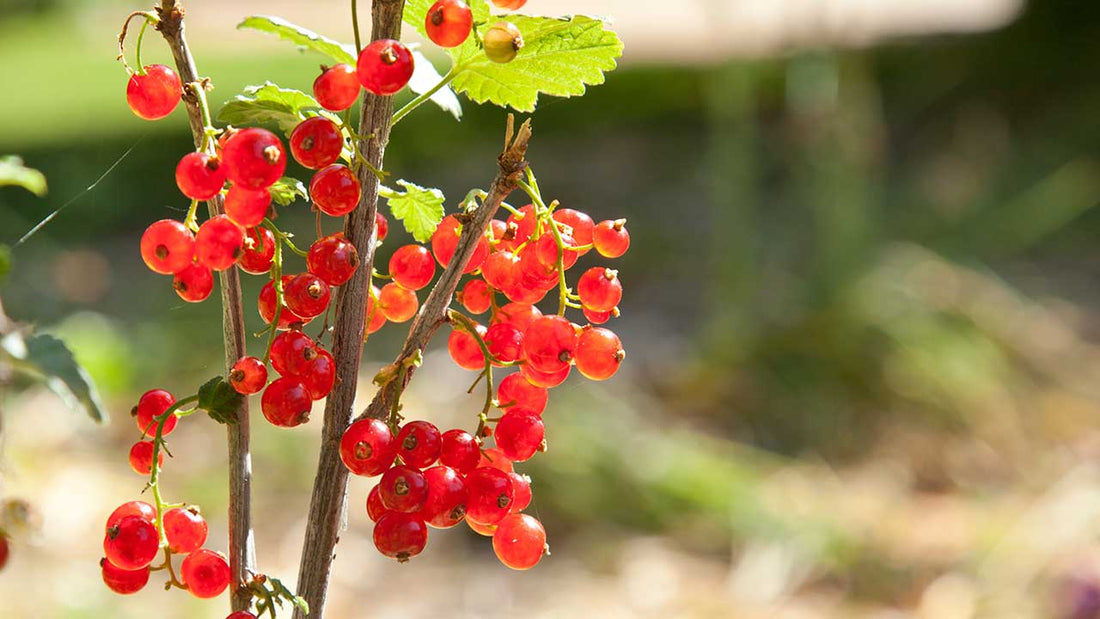Growing Currants Is Easy
Add currant bushes to your garden for an easy, deer-resistant edible that also grows in part-shade. If you live in USDA zones 3-8 currants are a must for your garden. In our video, Growing Currants, Tricia plants currants and gives tips on getting the best harvests.
Currants Bring New Flavors from Garden to Table
These attractive 3'-5' bushes will be covered in summer with glistening red or black berries, heralded for their simultaneously sweet and tart flavors. Enjoy them fresh or preserve them in jellies, jams, and cordials.
Shade Gardeners Can Grow Currants
If you're in a climate with hot summer sun, currants will grow best in part-shade or afternoon shade. 
Live with Deer? You Can Still Grow Edibles
Good news! Although deer will browse their way through most plants we want to eat, they show little interest in currants. So if you have filled your garden with deer-resistant plants, now you can add some edibles to that group. You may want to fence your currant when it is small but as it matures it should be able to withstand some browsing from deer. Rhubarb is another deer-resistant edible that grows well in sun or part-shade. Note that deer will still browse deer-resistant plants and the best way to protect them is with a fence or using deer repellents such as Plantskydd Deer Repellent Powder. Artichokes are deer-resistant but need to be in the full sun section of your garden, where they will put on a dramatic show.
Train Currants as an Espalier of Branches Against a Fence
Vern Nelson in The Oregonian has directions to espalier currants to act as a screen or a decorative accent.
Grow Currants in Containers
The natural growth habit and height of currants makes them an excellent choice for container gardening.
Harvesting Currants
Cornell University suggests picking the currant flowers the first year the bush is growing, to promote plant vigor. You will have a small harvest the second year and by the third year your currant bush will produce a full harvest. More from Cornell on picking the currants: Currants...ripen over a two-week period in June. Berries do not drop immediately upon ripening, so they usually can be harvested in one or two pickings. Currants can be picked in clusters. ... Wait for fruit to turn color before picking. ... Currants require some trial and error to determine the right time.
Pruning Currant Bushes
We have succinct pruning instructions from Cornell (emphasis added): Prune currants...when the plants are dormant in late winter or early spring. Remove any branches that lie along the ground as well as branches that are diseased or broken. Ribes species produce fruit at the base of one year old wood. Fruiting is strongest on spurs of two and three year old wood. After the first year of growth, remove all but six to eight of the most vigorous shoots. At the end of the second growing season, leave the 4 or 5 best one-year-old shoots and up to 3 or 4 two-year-old canes. At the end of the third year, prune so that approximately 3 or 4 canes of each age class should remain. By the fourth year, the oldest set of canes should be removed and the new canes allowed to grow. This system of renewal ensures that the plants remain productive because young canes always replace those that are removed. A strong, healthy, mature plant should have about eight bearing canes, with younger canes eventually replacing the oldest.
Peaceful Valley Black Currant Bushes are Disease Resistant
We only sell disease resistant black currants. Black currants are more susceptible, whereas red currants are somewhat resistant to white pine blister rust. For more information about currants read our Growing Guide, and article from Iowa State University Extension. Eat your currants in front of the deer!


9 comments
Jean, currants will grow well in zone 5. If you experience extremely hot summers, you may want to plant in a location that gets some afternoon shade, or you could also put up some shade cloth. The variety you grow is purely a personal preference. I would take a look at the descriptions of the 3 varieties we sell and pick the one that sounds good!
I am in zone 5, on the eastern slopes/ Prarie of CO. I grow raspberrir, blackberries beautifully….will currents grow well here also? And what variety?
Anita, Currants are rated to grow down to zone 3, so you should be ok. Raspberries are rated to zone 4, so not sure. We ship our plants out in winter (must be dormant), so when you receive them, you will need to heal them into a a pot or some soil and keep in a location that they do not freeze. Once you are ready to plant, they should be fine. Just make sure to keep the roots moist. After you plant them and before your next winter, just make sure that you mulch around the base of the plant.
I live in Custer, SD and would like plant red currant berries and raspberries, as well blueberries
Any suggestions, we are in zone 3-4
Cathy, you can only grow currants in full sun in areas that are cooler in the summer. They might be best in an area that gets afternoon shade. I would fence them if you have deer. Even though the deer may not be a problem, if enough deer browse them then you have a problem. Better to be safe than to have the deer nibble your plants to death.